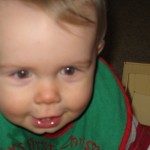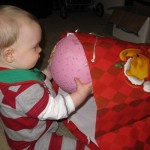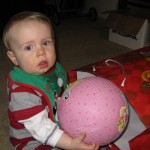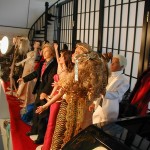BOTTOM-UP EMPOWERMENT: PENNY HARVEST ENGAGES SCHOOL CHILDREN IN SERVICE-LEARNING
Empowerment Organization is a method for motivating people “from the bottom up.” It includes “The One Small Thing” exercise, looking for a small action that many people will feel able to take as the first step in building grass-roots, bottom-up empowerment and community involvement.
Here is a wonderful example of “One Small Thing,” The Penny Harvest fund-raiser sponsored at elementary schools throughout the USA by the Common Cents Organization. Begun in 1991 when four-year-old Nora Gross asked her father, co-founder Teddy Gross, for help in feeding a homeless man, since then, over $7 million in pennies has been collected by school children and used to found a variety of projects in their local area.
Not only are pennies collected throughout neighborhoods, but then the students spend weeks learning about the grant-making process from the bottom up, eventually deciding on their own where Penny Harvest grants will be made.
I quote from the article written by Darcy Tomky for the Holyoke Enterprise (MA) newspaper , “Elementary Students Explore The Penny Harvest Grant-Making Process” (I have removed the names of students mentioned):
With 1,020 pounds of pennies collected, Holyoke elementary and high school students have dived into the second phase of the Penny Harvest philanthropic project.
The students have the opportunity to award a $1,000 grant to a non-profit organization. Now the question is: who should receive the money?
A roundtable committee made up of 14 elementary students has been formed to answer that question. Meeting once a week with high school sponsor T_____ and her high school leadership class student coaches, they are learning about the grant making process…
…The students have devoted themselves to being “a group of committed people working together to help meet important needs in the community.”
On their fourth week of the project, T_____ noted the students have learned about the democratic process by taking oaths and assigning roles such as president and secretary. They have also explored terms like community and philanthropy.
According to high schooler B_____, the project is not just about giving away money; it is also focused on service. One of the objectives of the Penny Harvest is to improve neighborhoods through service projects the students will plan and execute in addition to awarding a grant.
The next step in the grant making process is to “identify the issue the kids as a whole care about,” said T____. The roundtable discussed the question, “What do you see around you that you want to see changed?”
The roundtable developed a survey to find out what issues other elementary students care about. The survey, distributed by roundtable members on Thursday, March 5, gave students several options of who they would like to receive the funds such as sick animals, people without homes, disabled children and elderly people.
Once the issues are narrowed down, students will research the them to find what causes the problems and ways to solve or improve the situation. The high school coaches will also research specific non-profit organizations that address those issues.
The next step in the process will be to conduct an application and interview process with the non-profits. Students will follow up with letters of acceptance or decline.
Once a non-profit is chosen, the roundtable will finish up by planning a celebration party for elementary students and the recipient of the Penny Harvest grant. They hope to award the check in late spring.”
This is bottom-up motivation: everyone can donate and collect pennies. With that first step comes community involvement in the larger project, helping students learn about service and providing services for those in need.
See Empowerment Organization for more examples and “The One Small Thing” Focusing exercise.
Creative Edge Focusing (TM)’s Culture of Creativity fights apathy by engaging every person at the Creative Edge of individual experiencing. Whether in Creative Edge Education or Creative Edge Organizations, Listening/Focusing Turns are used as a basic method for helping people to find and articulate their own Creative Edge.
Creative Edge Focusing and Creative Edge Listening can be used for problem solving at home and at work, alone, in parenting and relationships, during interpersonal conflict, and in group or community decision making situations. The Creative Edge Pyramid describes applications from Focusing Alone to Creative Edge Organizations.
For application in business settings, see my article, “Creative Edge Organizations: Businesses and Organizations As A ‘Kind’ Of Focusing Community” from The Folio: Thirtieth Anniversity Tribute edition at The Focusing Institute, www.focusing.org .
CREATIVE EDGE FOCUSING(tm): SELF-HELP SKILLS FOR HOME AND WORK
Free Downloads:
Complete Focusing Instructions Manual (17 pages)
“Ajas” Instantaneos Mini-Manual
Creative Edge Focusing (www.cefocusing.com ) teaches two basic self-help skills, Intuitive Focusing and Focused Listening, which can be applied at home and at work through The Creative Edge Focusing Pyramid.
Based upon Gendlin’s Experiential Focusing (www.focusing.org ) and Rogers’ Empathic Listening, our website is packed with Free Resources and instructions in these basic self-help skills. Learn how to build Support Groups, Conscious Relationships, and Creative Edge Organizations based upon these basic skills of emotional intelligence.
You can try out “Focusing: Find Out What Is Bothering You.”
Click here for a free Intuitive Focusing Mini-Course
Click here for a free Focused Listening Mini-Course
See Core Concept: Conflict Resolution to find a complete mini-course on Interpersonal Focusing and Conflict Resolution, including Rosenberg’s Non-Violent Communication, Blanchard’s “One Minute Apology,” Patricia Evan’s books on Verbally Abuse and Controlling Relationships, McMahon’s Beyond The Myth Of Dominance, and much more.
See Core Concept: Intimate Relationship to find a complete mini-course on increasing intimacy and sexuality, including the “Sharing Your Day” exercise, Listening/Focusing Partnerships for The Way of Relationship, untangling and equalizing desire, tantric sexuality, and much more.
Download complete Instant “Ahah!” Mini-Manual, in English and Spanish, from CEF Website, or download from links at top of this blog.
Find links to free articles, personality tests, multi-media Self-Help training, Classes and workshops
Dr. Kathy McGuire, Director




















